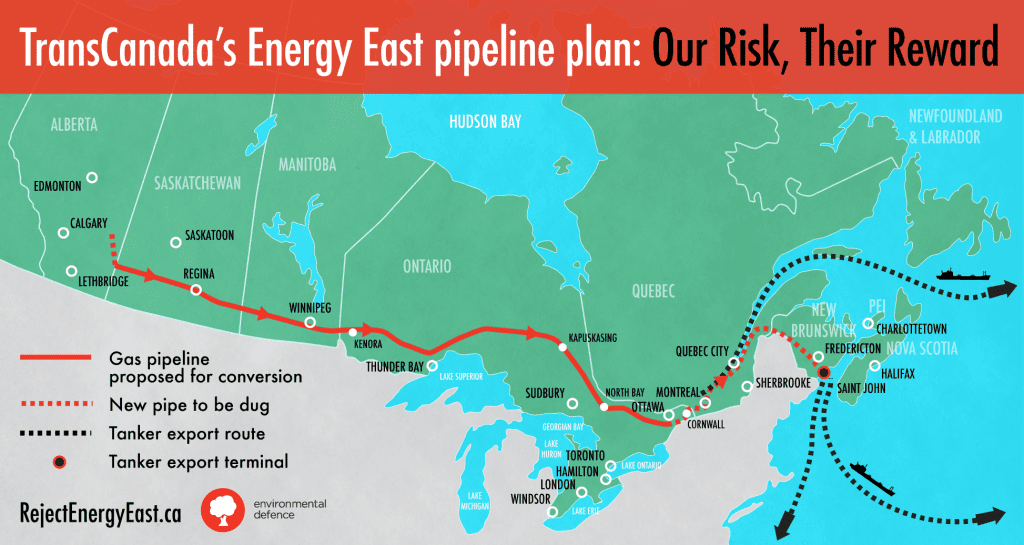This week, the National Energy Board kicked off its Energy East review with panel sessions in Saint John, New Brunswick. As TransCanada and its backers continue to tout the supposed economic benefits of the risky pipeline proposal, now’s the right time for a reminder that Energy East would be an export pipeline. It’s one more reason to tell Ottawa to reject Energy East.
TransCanada’s proposed Energy East pipeline would have the capacity to carry 1.1 million barrels of crude oil per day from Alberta to New Brunswick – the largest tar sands pipeline ever proposed. At the panel sessions in Saint John, TransCanada made the same inaccurate claim it’s been touting for years: Energy East will reduce crude oil imports to Canada from countries like Saudi Arabia, Algeria, Nigeria and Venezuela. A look at the facts shows that this is simply not the case.
According to TransCanada’s own application, up to 90 per cent of crude oil from Energy East would be shipped unrefined out of Canada via tankers. Energy East is an export pipeline, not a made-in-Canada energy solution. Refineries along the proposed pipeline route are at or near capacity and can’t take any significant amounts of oil from Energy East.
That’s confirmed by what the oil industry itself is saying: an Enbridge advisor said that oil flowing through “any other (pipeline) project beyond Line 9 would have to be for markets beyond Quebec.” A plant manager at the Irving Oil refinery, the proposed Energy East terminus, admitted that Energy East crude is “way more than we would ever use at this refinery, so the bulk of it would all be exported.”
Eastern Canadian refineries are already being supplied by North American crude from other sources, including 200,000 barrels per day (bpd) from the United States, 100,000 bpd from Atlantic Canada, and 250,000 bpd of tar sands oil from Enbridge’s Line 9. In fact, in 2014, just 14.1 per cent of eastern Canada’s oil imports came from Saudi Arabia, Algeria, Nigeria and Venezuela, the countries TransCanada constantly lists as sources of oil that Energy East will replace.
TransCanada suggests that eastern Canadian refineries would welcome the chance to process Energy East oil because it would supposedly be cheaper than overseas imports. This is inaccurate: the remaining price differential between tar sands oil and global crude prices is small. In a global market flooded with cheap oil, refiners are on the lookout for the cheapest barrel of oil—and the tar sands oil that Energy East would transport is some of the most costly in the world to produce and refine.
Most recently, Irving Oil president Ian Whitcomb said the Saint John refinery would continue to purchase Saudi oil even if Energy East goes ahead. Why? Because it’s cheaper and easier to process.
The oil industry itself is saying Energy East crude is for export and eastern Canadian refiners admit they will continue to import oil from the very same countries pipeline backers are scaremongering about. Maybe that’s why Energy East backers are increasingly resorting to misleading and offensive messages to scare Canadians about foreign oil.
What we do know is that Canadians would benefit very little from the project. TransCanada is asking us to support a massive new pipeline that would cross nearly 3,000 lakes, rivers and streams, put the drinking water of over 5 million Canadians at risk, and lock in new fossil fuel infrastructure that could further increase Canada’s climate pollution, all for the sake of shipping crude oil overseas.
Now’s the time to reject this tar sands export pipeline and instead speed up Canada’s transition to a low-carbon economy.
Tell our elected federal officials to reject the risky Energy East pipeline.










